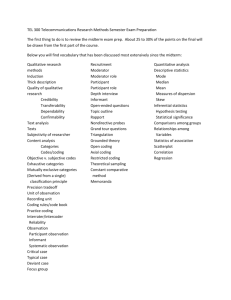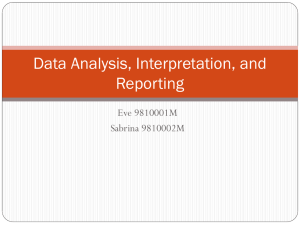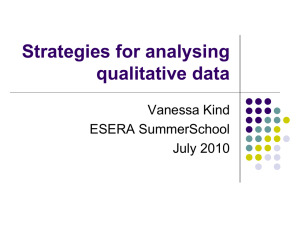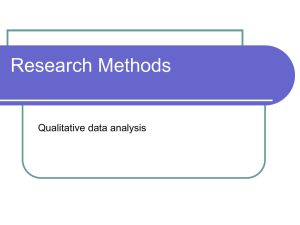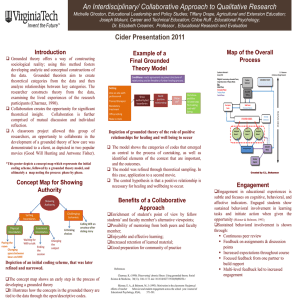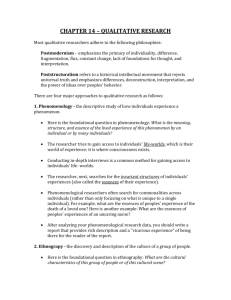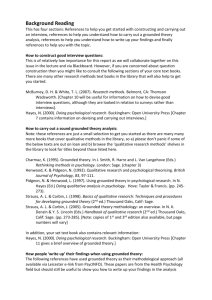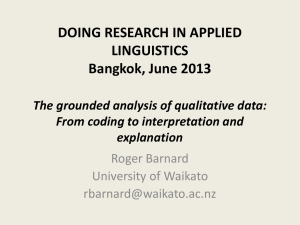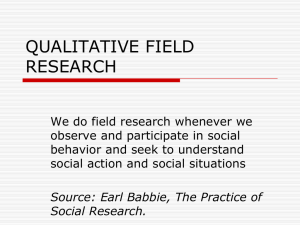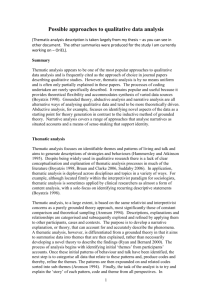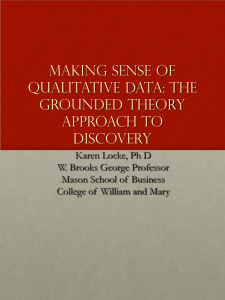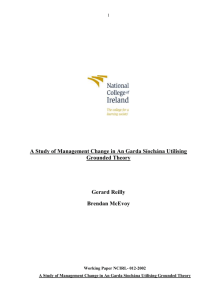Analysing and Presenting Qualitative Data
advertisement
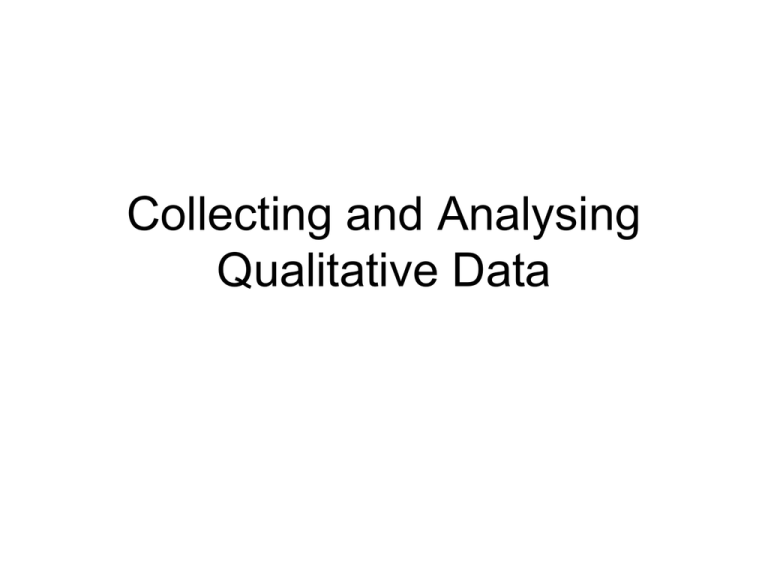
Collecting and Analysing Qualitative Data Objectives After this session you will be able to: • Describe some of the principles of qualitative data analysis. • Select appropriate qualitative analytical methods, including grounded theory approaches. • Apply qualitative methods to produce valid, reliable and trustworthy data. • Make use of the ‘voice’ of the researcher. Definition Qualitative analysis is (or should be) a rigorous and logical process through which data (usually words, but also photographs and other visual media) are given meaning. Qualitative researchers argue about…. • How data should be analysed. • The extent to which data should be analysed (should data be presented to ‘speak for themselves’?) • The role of the researcher in the research process. • The status and ‘undeniability’ (or otherwise) of findings. • Whether theory building is possible or desirable. One approach: analytic induction Steps in the coding process Transcribe the data Generating theory Focused reading Collect/code/ collect Familiarization Secondary data analysis • In-depth analysis of a sub-set of the original data, or • Application of a new perspective or conceptual focus to the data. Reflexivity • Epistemological reflexivity: researchers reflect on their assumptions about the world and about the nature of knowledge. • Personal reflexivity: researchers reflect upon how their personal values, attitudes, beliefs and aims have served to shape the research. Approaches to analysis: content analysis Establish criteria of selection Identify classes • Common • Special • Theoretical Analyse data • Summarize content • Explicate content • Structure content Approaches to analysis: grounded theory Grounded theory: • Does not begin with prior assumptions about hypotheses, research questions or what literature should underpin the study. • But researchers will have a competent level of knowledge about the area. • Research commences with a defined purpose, but also with the realization that this purpose may become modified or even radically altered during the research process itself. Grounded theory: open coding • Ask the data a specific and consistent set of questions, keeping in mind the original objectives of the research study. • Analyse the data minutely, but also include as many categories, examples and incidents as possible. • Frequently interrupt the coding to write a theoretical account. As the data are being coded, ideas or theoretical perspectives may arise. • Do not assume the analytical relevance of any traditional variable such as age, gender, social class, etc. until its relevance emerges from the data. Grounded theory: axial coding This means specifying: • A category (phenomenon) in terms of the conditions that helped to give rise to it. • The context in which it arises. • The actions and interactions that stem from it. • Its consequences. Grounded theory: axial coding Grounded theory: axial coding Grounded theory: selective coding Through selective coding, core categories are sought through which a ‘story’ can be told. This process involves: • Finding a story line formulated around core categories. • Relating sub-categories to the core categories. • Validating these relationships against the data. • Filling in categories that need further refinement. Grounded theory: selective coding Grounded theory: theoretical sensitivity Theoretical sensitivity is: the ability to give meaning to data, the capacity to understand, and [the] capability to separate the pertinent from that which isn’t. (Strauss and Corbin, 1998: 42). Achieved through: • The literature, which helps highlight issues and what might be important and unimportant. • The professional experience of the researcher, showing what is important in the field of research chosen, and how things work, allowing events to be more clearly understood and interpreted. • Personal experience, including experience in research, which can facilitate the making of comparisons. • The analytical process itself, which can provide insights into the meaning of the data. Validity in qualitative analysis Type of technique Technique Analytic Member checking. Expert checking. Exploring rival explanations. Writing memos. Testing hypotheses in data analysis. Analysing negative cases. Performing a literature review. Presentation Providing an audit trail. Providing evidence that supports interpretations. Acknowledging the researcher perspective. Providing thick descriptions. Reliability Internal reliability is improved by the use of: • Data gathering – more than one observer in the field. • Data analysis – multiple researchers for interpretation of the findings. Summary • • • • • The main focus of qualitative analysis is to understand the ways in which people act and the accounts that people give for these actions. Approaches to qualitative data analysis include content analysis and grounded theory. Content analysis involves locating classes or categories within the data. These categories are usually derived from theoretical models. Grounded theory uses a process of open, axial and selective coding to develop categories and theories inductively from the data. Due to the lack of non-probability sampling methods, qualitative analysis is open to accusations of invalidity. However, claims for the validity of results can be strengthened, for example, by eliciting the views of research participants. The reliability of qualitative research can be strengthened by using multiple cases, or by supporting assertions using numerous examples, or by verifying the analysis using other researchers. Concepts such as credibility, authenticity, honesty and openness are also important in qualitative research. CAQDAS programs provide useful functionality for qualitative data coding and analysis. But before embarking on the process of learning a program, make sure that the quantity of data requiring analysis justifies the expenditure of time.
